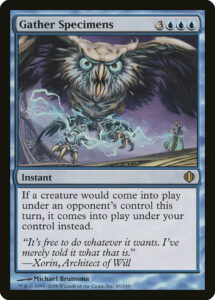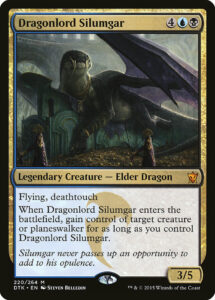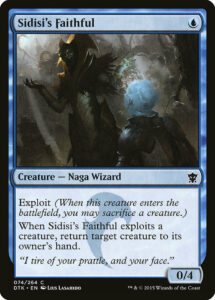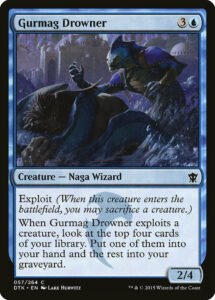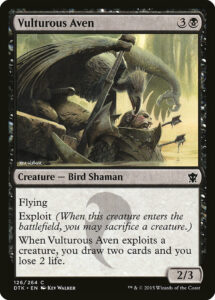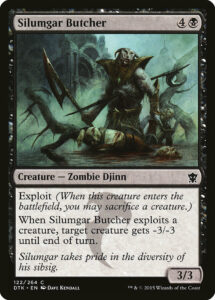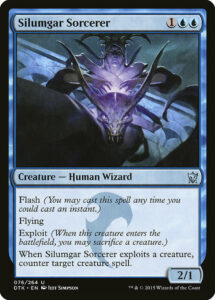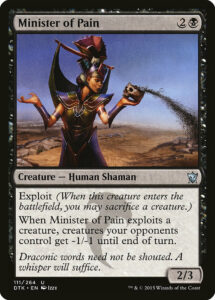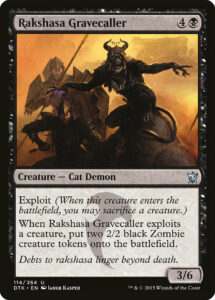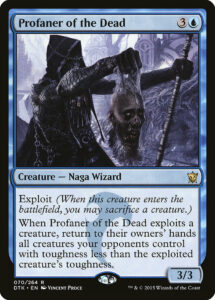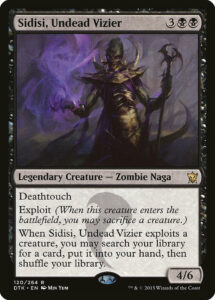As of today, there are 21 creatures with Exploit. It’s only been featured in two sets, Dragons of Tarkir and Innistrad: Crimson Vow (with each Modern Horizons contributing one Exploit creature). Exploit is a sweet mechanic with a ton of modality. Sometimes, Exploit is Evoke, where a spell masquerades as a creature (that immediately dies). Sometimes, it’s an option you decline and you just get a vanilla creature. And sometimes, it’s a value engine where you convert sacrifice-friendly creatures into spells.
I’ve found Exploit to underperform in Crimson Vow draft, but it wasn’t immediately obvious why from looking at the set spoiler. The creatures seem reasonably strong, their Exploit abilities generate advantages, and there’s definitely support for sacrifice themes. So, what happened?
In this two-part series, we’ll get to the bottom of our initial question and get a sense of what makes Exploit tick. How does one evaluate an Exploit creature? What kinds of attributes make cards over- or under-perform? How can an environment or support cards shift these evaluations? We’ll start today by reviewing all cards from Exploit’s introductory set, Dragons of Tarkir.
The parameters
Because Exploit has many knobs (things that Play Design can change to balance and strengthen each card with the mechanic), it has many components to analyze. We’ll focus on five dimensions: four specific to each individual card, and one for each set as a whole.
Exploit Spell & Mana Value: Each Exploit creature effectively casts a spell when they Exploit. What is that spell? And more importantly, what is its mana value? This provides a reasonably good approximation of how much value you receive by Exploiting. In general, if you sacrifice a creature cheaper than the mana value, you’re getting a lot of bang for your buck.
Here, mana value isn’t always a whole number—effects like Counterspell and Night’s Whisper cost about 2.5 mana (they usually cost 3 and come with a minor advantage, or cost 2 and have downsides/restrictions). We’ll also fudge it a bit, since an instant speed Unsummon is far more powerful than a sorcery speed one, but we’ll still call it a 1 mana effect.
Spell Versatility: How easy is the spell to use? Disfigure generally has targets while Naturalize is much more situational. Lightning Bolt is the kind of spell you can always use, while not all decks are looking to cast Lava Spike.
Our next two dimensions pertain to the creature and how it relates to its Exploit ability.
Creature’s Rate: How good is the creature on its own? Stronger creatures and creatures with keywords don’t need to Exploit often in order to be impactful, while under-statted creatures basically always need to Exploit (and are more likely to sacrifice themselves to their own Exploit ability).
Mana Value relative to Exploit spell’s Mana Value: How much more expensive is the creature than the spell it casts by Exploiting? If the creature’s mana value is close to the Exploit spell it casts, it’s generally fine for it to Exploit itself. If there’s a big difference, you’ll rarely be advantaged by self-Exploiting and need the creature’s Rate to matter more.
Our final dimension is context, and it’s the same for most cards (with a few exceptions we’ll get into).
Context: This is all the ways the full set affects each dimension. It’s a measure of things like: How much sacrifice fodder is there? And what is the average mana value of a sacrificed creature? If most Exploit spells are mana value 2 and most Exploit fodder are mana value 1, then you have an easy time generating value via Exploiting. If the reverse is true and you’re sacrificing more expensive creatures to cast cheaper spells, then Exploiting is weaker.
Exploit in Dragons of Tarkir
Context: This set introduced Exploit. There was a lot going on between the dragons theme, all five allied color pairs each having their own mechanic, Megamorph adding complexity and an increased focus on three drop creatures, and the final pack of Fate Reforged adding plentiful bombs and introducing enemy color themes.
Exploit was more a texture added to a deck than a thoroughly dedicated theme. Cards like Palace Familiar and Shambling Goblin provided cheap, easy-to-use sacrifice fodder, while Youthful Scholar offered massive advantage for a high cost and Dutiful Attendant was often too expensive and situational to properly take advantage of.
These factors meant that Exploit was reasonably strong and not too hard to build a deck around, but there wasn’t so much support that it was easy to do multiple times in a game or always worthwhile. As we’ll see after going through the individual cards, Exploiting was usually good, given that it wasn’t hard to get a bonus on mana advantage by Exploiting a two mana creature.
Sidisi’s Faithful
Exploit Spell & Mana Value: Unsummon, 1
Spell Versatility: High
Unsummon has plenty of uses: it disrupts your opponents’ creatures, can bounce your own, knocks off auras, and resets enters-the-battlefield abilities (among other uses). It basically always has multiple targets. All that makes it highly versatile (even though it’s card disadvantage, unless you’re getting value from the creature you sacrifice).
Creature’s Rate: Moderate
Kraken Hatchling isn’t a strong card, but it’s a fine blocker. All one drops are better in formats with Exploit, since you can convert them into more expensive spells.
Mana Value relative to Exploit Spell’s Mana Value: 0
This is the best deal you could ever hope for from an Exploit creature. There is no loss in mana if it Exploits itself.
Overall, Sidisi’s Faithful doesn’t do anything particularly well on its own, but it doesn’t need to. Simply being a 1 mana creature is a huge plus alongside Exploit creatures. The fact that it provides a versatile spell at an outstanding rate and blocks well before being Exploited are excellent bonuses. This unassuming card overperformed but provides strong lessons for what to expect with future cheap Exploiters.
Gurmag Drowner
Exploit Spell & Mana Value: Impulse + Strategic Planning, 2
Spell Versatility: High
Drawing cards is always good, and blue-black is generally good at taking advantage of cards in their graveyard.
Creature’s Rate: Moderate
A four mana 2/4 is fine, but nothing exciting. Those stats are a bit better in blue-black, since the color combination tends to require defense in the midgame more than offense. The defensive stats help offset the tempo loss by sacrificing an early creature.
Mana Value relative to Exploit Spell’s Mana Value: 2
Gurmag Drowner wasn’t an especially strong card, but it wasn’t embarassing. This is a fine example of lower powered card—the fail rate of a 2/4 isn’t awful, and if you’re desperately looking for a specific card, you can always cash it in to dig deep into your deck.
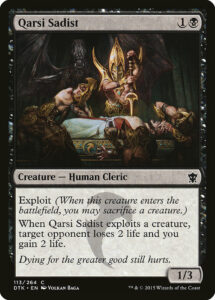 Qarsi Sadist
Qarsi Sadist
Exploit Spell & Mana Value: Vampire’s Kiss, 0.5
This effect is so minor it always appears as an added bonus, rather than card’s primary effect. The few cards it does appear on as the primary effect are spells that can be cast repeatedly (Syphon Life, Brush with Death, Tendrils of Agony).
Spell Versatility: Low
Unless you’re killing your opponent or 2 life is enough to let you survive and win the game, most decks and situations don’t improve by having this effect.
Creature’s Rate: Low
This is an okay blocker. as with Sidisi’s Faithful, cheap creatures are better in formats with Exploit, but this doesn’t provide any value when Exploited.
Mana Value relative to Exploit Spell’s Mana Value: 1.5
Here, we have a mostly bad card. It being a two drop means it can block for a turn or two and then be cashed in by another Exploit creature, so the floor isn’t too low. It’s also a handy sacrifice outlet for a Youthful Scholar in a pinch. Those factors keep it from being awful and tells us what good Exploit filler can be.
Vulturous Aven
Exploit Spell & Mana Value: Night’s Whisper/Succumb to Temptation/Painful Lesson, 2.5
As with Counterspell, this effect can be done at two mana, but is more commonly done at three with some minor upside. This costing 2.5 mana means you’re generally getting an advantage when sacrificing a two mana creature and getting a large advantage when sacrificing a one mana creature or creature with a death trigger.
Spell Versatility: High
Card advantage is always welcome. Sacrificing board presence and life for card advantage is a harder deal in 2021 than it was in 2015, since cheap creatures are stronger now than they used to be.
Creature’s Rate: Moderate/High
A four mana 2/3 flying is decent, though not amazing. It was a lot stronger back in 2015.
Mana Value relative to Exploit Spell’s Mana Value: 1.5
This difference is small enough that it’s not embarrassing to sacrifice Vulturous Aven to itself.
Vulturous Aven doesn’t read super impressively, but its combination of a high value Exploit spell, flying, and decent stats made it arguably the strongest common black creature in Dragons of Tarkir.
Silumgar Butcher
Exploit Spell & Mana Value: Last Gasp, 2
Spell Versatility: High
Removal is good, and -3/-3 is usually enough to kill something. It can’t kill the best creatures and it’s much better at instant speed, but this can sometime kill large creatures post-combat.
Creature’s Rate: Low
Even in 2015, Hill Giants weren’t good enough anymore. At five mana, this had to Exploit to not be embarrassing.
Mana Value relative to Exploit Spell’s Mana Value: 3
The large mana differential means you lost a lot of mana if Silumgar Butcher Exploited itself. This combined with its low rate made the card weaker than it looked. Vulturous Aven proved a far stronger card because of how easy it was to use, how cheap it was, and that its base rate wasn’t awful. This is a great example of a card that looks good (because it’s removal) but underperforms because you’re overpaying for both the removal and the creature.
Silumgar Sorcerer
Exploit Spell & Mana Value: Essence Scatter, 2
Spell Versatility: Moderate
Most decks have plentiful targets, but reactive spells like this demand you not spend mana on your turn. Proactive spells are just easier to use.
Creature’s Rate: Moderate/high
A three mana 2/1 Flying with Flash isn’t amazing, but it’s worth three mana (especially at uncommon in 2015). We’ve since seen Dimensional Infiltrator, Rattlechains, and Spectral Adversary at two mana, but those are rares and come from an era where creatures have gotten even stronger.
Mana Value relative to Exploit Spell’s Mana Value: 1
Silumgar Sorceror doesn’t do anything especially well, but it’s fine rate and flexibility make it more than the sum of its parts. It is awkward holding up on your opponent’s turn and having nothing to counter, but the fail case of a 2/1 Flash Flying is good enough even if you don’t Exploit.
Minister of Pain
Exploit Spell & Mana Value: Marsh Casualties/Make Obsolete, 2.5
Spell Versatility: Low
This can be a blowout, but it requires specific circumstances to function. Other times, it does nothing.
Creature’s Rate: Moderate
A three mana 2/3 is nothing to write home about, but it blocks well enough in the early game.
Mana Value relative to Exploit Spell’s Mana Value: 0.5
Minister of Pain‘s power lies in its modality. It’s a fine (if unexciting) creature that can sometimes cast an enormously powerful spell. It’s close enough in mana value that you’re happy to cash it in for Mash Casualties, and quite happy if you can convert a cheaper creature into a potent removal spell or attack setup. It’s also highly context sensitive—Dragons of Tarkir didn’t have a ton of 1 toughness creatures (especially when many of them had Megamorph and would be bigger). In Crimson Vow, this would kill a fair number of good common creatures.
Rakshasa Gravecaller
Exploit Spell & Mana Value: Moan of the Unhallowed, 4
Spell Versatility: High
Like card advantage, adding significant board presence is always welcome. Unlike card advantage, it can immediately translate into killing your opponent.
Creature’s Rate: Moderate/high
A 3/6 has a large impact on the board. It’s by no means outstanding, but given that Exploit creatures tend to be under-statted due to the extra value of Exploit, this is a pretty massive creature.
Mana Value relative to Exploit Spell’s Mana Value: 1
With good stats and an expensive and versatile Exploit ability, it’s facile to get strong value from Rakshasa Gravecaller. The fail cases of two 2/2s or one 3/6 aren’t bad, either. This is what a very strong Exploit creature looks like—all options are good, and Exploiting is outstanding, even if you aren’t sacrificing a creature with a death trigger.
Profaner of the Dead
Exploit Spell & Mana Value: None, highly variable
This spell does not exist. Normally, Evacuation effects hit all creatures, not just your opponents’. This could be close to an Overloaded Cyclonic Rift, but actually getting that value requires a large creature you’re happy to sacrifice (which is unusual) or your opponent having a relatively small board.
Spell Versatility: Low
This is not a simple effect to use. It requires specific kinds of board state: your opponent must have a board you’re able to bounce, you need a creature big enough to bounce all of their important creatures, and you need to have sufficient resources to take advantage of trading card advantage for tempo (which runs counter to how almost every other Exploit card works).
Creature’s Rate: Low/moderate
Hill Giants come with upside nowadays. If you’re not Exploiting for value, you’re getting a bad deal.
Mana Value relative to Exploit Spell’s Mana Value: High variable
Profaner of the Dead has an exciting looking effect that generally underperformed. The high variability and ceiling of the effect made it hard to properly evaluate. But as you played with and against the card, you saw how hard it was to set up and take advantage of—it basically only worked when the board was stalled and you could afford to sacrifice your biggest creature to set up a massive attack. Profaner of the Dead has a very high ceiling, but there are only a few, very narrow paths up to it from a fairly low floor.
Sidisi, Undead Vizier
Exploit Spell & Mana Value: Diabolic Tutor, 3.5
Spell Versatility: Extremely high
Drawing a card is good. Drawing the exact card you want is outstanding.
Creature’s Rate: High
It’s bigger than Rakshasa Gravecaller and has excellent stats to leverage Deathtouch both offensively and defensively.
Mana Value relative to Exploit Spell’s Mana Value: 1.5
You’re not happy to cash in Sidisi to itself, but it’s not an awful deal. And the high mana value of the effect means you’re likely going to have a cheap creature you’ll be happy to cash in for an effect more expensive than it.
Rakshasa Gravecaller was an example of a very strong, balanced Exploit creature. Sidisi, Undead Vizier is an example of an incredibly strong Exploit creature. The stats are fantastic on their own. The ability is strong, has a sufficiently high mana value that it’s easy to get a mana advantage by Exploiting most creatures, and Sidisi is expensive enough that you’ve probably got a creature to sacrifice.
And that’s every Exploit creature in Dragons of Tarkir. We’ve run the gamut from hard-to-evaluate, to obviously weak, to surprisingly strong, to nearly busted. We’ll keep all of this information in mind next time when we return to the present, analyze the Exploit cards of Crimson Vow, and conclude why it’s weaker in Crimson Vow than it was in Dragons of Tarkir.
And, as always, thanks for reading.
Zachary Barash is a New York City-based game designer and the commissioner of Team Draft League. He designs for Kingdom Death: Monster, has a Game Design MFA from the NYU Game Center, and does freelance game design. When the stars align, he streams Magic (but the stars align way less often than he’d like).

